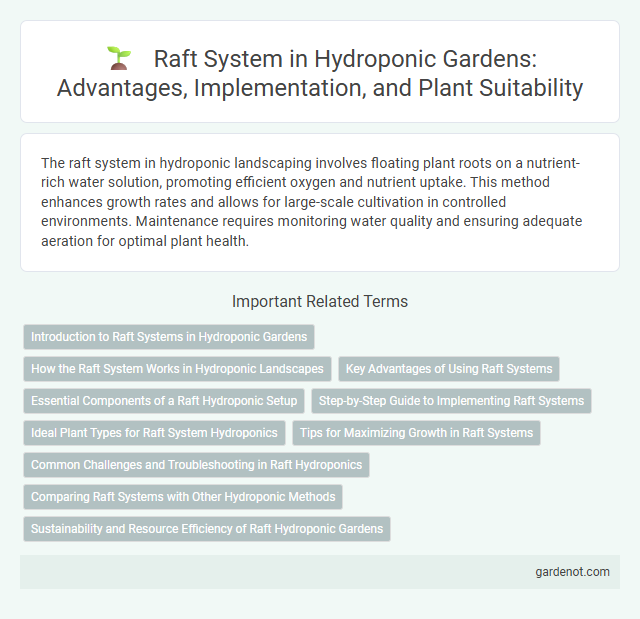The raft system in hydroponic landscaping involves floating plant roots on a nutrient-rich water solution, promoting efficient oxygen and nutrient uptake. This method enhances growth rates and allows for large-scale cultivation in controlled environments. Maintenance requires monitoring water quality and ensuring adequate aeration for optimal plant health.
Introduction to Raft Systems in Hydroponic Gardens
Raft systems in hydroponic gardens utilize floating platforms that support plants while their roots are submerged in nutrient-rich water, promoting efficient oxygen and nutrient uptake. This method is highly suitable for leafy greens and herbs, enabling rapid growth and maximizing space with minimal substrate use. Oxygenation and water quality control are critical factors to optimize plant health and yield in raft-based hydroponic setups.
How the Raft System Works in Hydroponic Landscapes
The Raft System in hydroponic landscapes operates by floating plants on a nutrient-rich water solution, allowing roots to hang directly into the water for optimal nutrient absorption. This method promotes efficient oxygenation and continuous nutrient supply, supporting rapid growth and healthy development. By eliminating soil, the Raft System minimizes pests and diseases, ensuring a cleaner and more sustainable planting environment.
Key Advantages of Using Raft Systems
Raft systems in hydroponic landscapes offer efficient water and nutrient distribution by floating plant roots directly on the nutrient solution, ensuring optimal oxygenation and growth rates. Their simplicity and scalability reduce setup and maintenance costs while enabling high-density planting that maximizes space utilization. Consistent water circulation in raft systems prevents root diseases and supports uniform crop development, making them ideal for commercial hydroponic farming.
Essential Components of a Raft Hydroponic Setup
A raft hydroponic system primarily consists of a nutrient reservoir, a floating raft made of foam or similar buoyant material, and net pots to hold plants securely. An aeration system is crucial to supply oxygen to the nutrient solution, preventing root suffocation and promoting healthy growth. Additionally, a water pump circulates the nutrient-rich solution, ensuring consistent delivery of essential minerals directly to plant roots.
Step-by-Step Guide to Implementing Raft Systems
Implementing a raft hydroponic system begins by selecting a shallow, nutrient-rich water reservoir paired with buoyant foam rafts to support plant growth. Next, precise placement of seedlings into pre-cut holes on the foam ensures optimal spacing for root expansion and nutrient absorption. Maintaining consistent water circulation, oxygenation, and nutrient balance throughout the system promotes robust plant development and maximizes yield efficiency.
Ideal Plant Types for Raft System Hydroponics
Leafy greens such as lettuce, spinach, and kale thrive in Raft System hydroponics due to their shallow root structures and fast growth rates. Herbs like basil, mint, and cilantro also perform well, benefiting from the constant nutrient availability and oxygenation in the nutrient solution. This system is less ideal for large, fruiting plants but excels in supporting plants requiring consistent moisture and nutrient access.
Tips for Maximizing Growth in Raft Systems
Maintaining consistent nutrient solution levels and ensuring proper oxygenation are vital for maximizing growth in raft hydroponic systems. Regularly monitoring pH levels between 5.5 and 6.5 optimizes nutrient uptake for plants like lettuce and herbs commonly grown in raft setups. Employing efficient water circulation and preventing algae buildup further enhance plant health and yield in hydroponic raft systems.
Common Challenges and Troubleshooting in Raft Hydroponics
Raft hydroponic systems commonly face challenges such as nutrient imbalances, root rot, and oxygen deficiency, which can severely impact plant growth and yield. Troubleshooting involves maintaining optimal nutrient solution levels, ensuring adequate aeration through air pumps or oxygenators, and monitoring water temperature to prevent pathogen proliferation. Regular inspection of roots for discoloration and using UV sterilizers or beneficial microbes help mitigate fungal infections and sustain system health.
Comparing Raft Systems with Other Hydroponic Methods
Raft systems offer superior oxygen and nutrient delivery compared to traditional media-based hydroponic methods such as NFT or drip systems, promoting faster plant growth and higher yields. This hydroponic technique utilizes floating rafts on nutrient-rich water, ensuring constant root submersion and optimal hydro root zone aeration absent in media-dependent setups. Hydroponic raft systems also reduce water and nutrient waste through recirculation, enhancing sustainability over single-pass methods like drip irrigation.
Sustainability and Resource Efficiency of Raft Hydroponic Gardens
Raft hydroponic gardens maximize water efficiency by recirculating nutrient solutions within a closed-loop system, significantly reducing water waste compared to traditional soil gardening. The floating rafts support plants in a controlled environment, allowing precise nutrient delivery and minimizing excess fertilizer runoff. This sustainable method conserves both water and nutrients, promoting eco-friendly urban agriculture with reduced environmental impact.
Raft system Infographic

 gardenot.com
gardenot.com